Our City: The Capital Regional District
Map One: The Capital Regional District
Contents:
I. Introduction: A Thumbnail Sketch of ‘Our City’ (a few statistics)
2. Can internal amalgamations save money? (not likely and let’s look at the experience in other areas)
3. Who or what is propelling the push towards amalgamation? (is there widespread community support?)
4. Building on our strengths, a better path to follow (what can provide the best bang for our buck)
Part I. Introduction: A Thumbnail Sketch of ‘Our City’
Did you know British Columbia is the only Province in Canada where the cities, towns, municipalities, and unorganized territories, underwent amalgamation over 50 years ago? Over five years beginning in 1965, it was the most extensive series of amalgamations in the history of Canada, and it was unique in that constituent members retained the power to oversee a sizeable portion of their internal affairs. It was the best of both worlds and to this day remains a model for managing the affairs of politically and geographically diverse communities across British Columbia.
Map Two: British Columbia Regional Districts
Regional Districts have a combination elected/appointed city structure (1) that is every bit as real as that found in cities like Calgary, Edmonton, Regina, Winnipeg, and Toronto. Did I say Toronto? Well, let’s not go there just yet. In Greater Victoria, our city is called the Captial Regional District (CRD), and it’s more extensive than you think.
It encompasses 2,370 square kilometers and includes 69 Islands, 13 municipalities and covers three electoral areas, all of which are located in and around the southern tip of Vancouver Island. Stretching from the outer Gulf Islands in the East to Port Renfrew in the West, then along the Strait of Juan de Fuc to the south and various mountain ranges to the north. The area has one of the most diverse and beautiful ecosystems in Canada (Ref Map One)
The CRD serves the interests of over 380,000 citizens and is guided by a Board responsible for more than 1,000 full and part-time staff, as well as 1,600 registered volunteers. It has a consolidated budget of nearly $700,000,000, and while the multiplicity of local governments may, at first blush, seem excessive, for the majority residing in this diverse area, it makes sense (survey results provided in Part 4).
In many discussions about amalgamation, the role the Regional District in managing ‘our city’, is generally lost. However, it is one of the keys to our success, one in which citizens can maintain close contact with both their locally elected leaders and support staff, yet accrue the benefits provided by a larger city structure.
Every local politician and the majority of staff know where the divisions of responsibility lie, however, the distinctions may not be as evident to many citizens (2). Overall, it’s a neat system, one in which the Province, for the most part, maintains an arm’s length relationship. It’s this separation of power that ensured the Regional District system has thrived across BC for more than 50 years. This outline from the CRD handbook:
“The CRD was created in 1966 as part of the BC Provincial Government’s initiative to establish the ‘regional district’ concept of local government province-wide. This governance concept was designed to address service requirements that transcend municipal boundaries and where municipal collaboration is required to achieve economies of scale.”
“Legislation enabling the creation of regional districts was introduced in 1965. Over the next five years, a total of 29 regional districts were incorporated. This did not happen all at once; the system was built up one regional district at a time using both incentives and, to a limited extent, mandates in the form of provincial legislation.”
The Regional District system has helped BC regions avoid many of the problems that plague other multi-jurisdiction cities across Canada and where several amalgamations have taken place with mixed results.  The best-known calamity was in Greater Toronto (GTA), where, in 1996, the Provincial Government forced amalgamation of East York, Etobicoke, North York, Scarborough, and York with the City of Toronto. Pushed to completion despite the strong objections of citizens in all six areas, to this day the Provincial Government continues to press its ideological finger into the eye of Canada’s largest city. Across BC, you seldom see the provincial government interfere with Regional Districts or their constituent members, a best practice that accounts for the relative peace experienced over the past five decades.
The best-known calamity was in Greater Toronto (GTA), where, in 1996, the Provincial Government forced amalgamation of East York, Etobicoke, North York, Scarborough, and York with the City of Toronto. Pushed to completion despite the strong objections of citizens in all six areas, to this day the Provincial Government continues to press its ideological finger into the eye of Canada’s largest city. Across BC, you seldom see the provincial government interfere with Regional Districts or their constituent members, a best practice that accounts for the relative peace experienced over the past five decades.
In the Capital Region, what many citizens may not realize is that with any amalgamation (e.g. Victoria-Saanich, perhaps including Esquimalt-Oak Bay; or in the West Shore communities of View Royal-Colwood-Langford; and, finally, with Sidney-North and Central Saanich) there wouldn’t be any change in responsibilities held by the CRD. It would remain our Capital Regional District regardless of those internal amalgamations. But, would those amalgamated communities be better than that which currently exists? Will they be more inclusive? Will they save taxpayers money? A few of those items will be explored in Part 2.
Figure Four
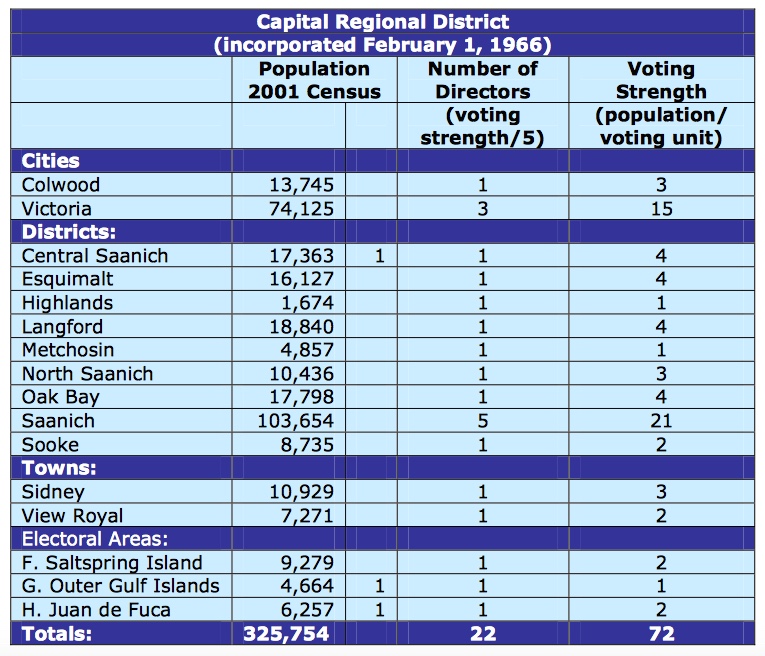
Part 2. Can internal amalgamations save money?
First, any suggestion that significant savings could be achieved by “economies of scale” is misleading at best and dishonest at worst. Realizing “economies of scale” was one of the core reasons for creating the Regional District System in the first place.
But, you may inquire, what about having one council instead of two, three or four, or having just one instead of thirteen? Cost-savings is not likely to occur as the amount of money now spent is a very small part of the overall budget:
“The cost of all elected councillors and mayors is approximately 0.47% of all municipal and CRD expenditures or $9.85 per capita. Within the region, there is one elected official for every 3,813 citizens. This is a highly representative system where elected officials instead of paid staff supervise the budgets and make policy decisions. It is also one where local elected officials have incentives to balance benefits and costs in their decisions.” (Footnote 3)
That costs are likely to rise when amalgamation takes place, is based on the fact salaried staff would need to be hired to perform duties now provided by elected officials on local councils. Strangely, it is this ‘cost-saving’ myth that often flows to the top in amalgamation discussions, primarily because it is pushed so hard by amalgamation supporters as in the sign below. For a full discussion of the costs, Link Here (reference Part 1 and the link to the original research paper)
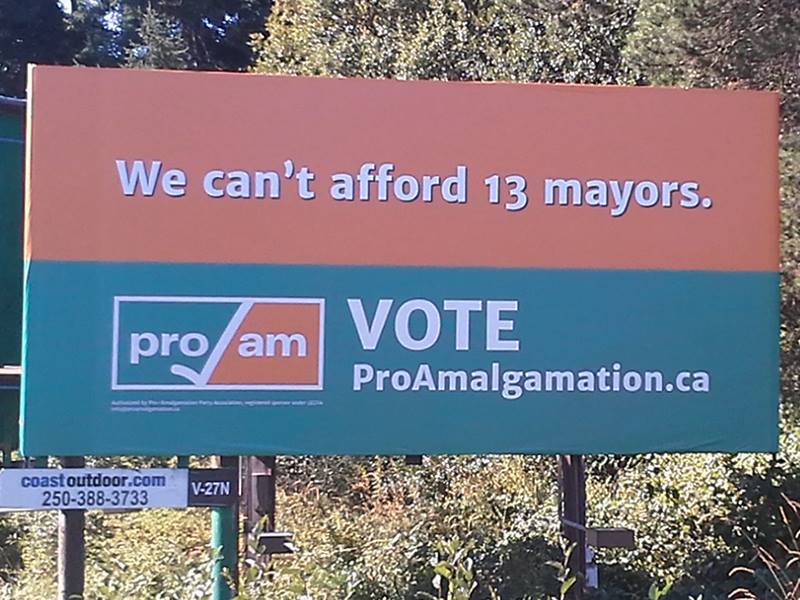
Comment: 4′ X 8′ signs like this were was prominently displayed by the Amalgamation Yes campaign during the 2014 Municipal elections. What the group failed to understand (or explain) is that if local Mayors and Councils were dropped, more staff would be needed to do the work previously performed by lower-paid elected officials and volunteers.
In a non-monetary area, both anecdotal and survey evidence (see Angus Reid Poll results in Part 4), suggests citizens prefer smaller systems as they tend to provide close contact with elected leaders and service personnel. In the 2018 election, this was demonstrated in every area by the number of local issues that rose to the top in the candidate and public debates.
What about the big-ticket cost items: Police, Fire, and Inside/Outside Workers. These four services account for a significant portion of municipal budgets and would be the most difficult to integrate. It is doable, but the challenges would be significant, costly and long-term in effect. Once accomplished would the new entity be more efficient and save money? Again, evidence from other areas in Canada where amalgamations have taken place, reveals this is seldom the outcome and, in many instances, costs rapidly increase. This can be partially attributed to the increasing complexity of the system.
While the number of personnel required to provide the same level of service might remain the same, there is often a steady increase at the upper and middle management levels as duties once performed by relatively low wage councillors and committees, is transferred too paid staff (administrative assistants, specialists, etc.).
Indeed, you may have one Police or Fire Chief, or one Municipal Administrator, but then your top-level and mid-management team (the most expensive positions) begins to grow. When this is accompanied by a reduction of front-line personnel, as happened within the Surrey RCMP (2), it does not take long for the public to notice the erosion in front-line service.
Would this be the case in a Victoria/Saanich merger, the one most often mentioned by local news outlets? Would an amalgamation prove to be more efficient? Perhaps in limited areas of police and fire, but within those two agencies, there is already a high degree of cooperation (e.g.the integrated Homicide and Robbery, Traffic Units, etc.), so don’t count on any difference in clearance rates for police or lower response times for fire and police. Each of the individual forces currently provides quality service that compares favourably with other police forces, large and small, across Canada.
In a 2015 summary of research relating to outcomes experienced in the Amalgamation of Police Forces, the following comments appeared in the Conclusion section:
“The analysis in this paper indicates that despite claims and popular assumptions surrounding police regionalization, large regional police services are not demonstrably more effective or efficient than medium-sized non-regional services. The primary reason is that policing seems to be mainly a local issue. In addition, there is good evidence to suggest that medium-sized police services (i.e. those policing about 50,000 inhabitants) are more successful in dealing with crime and operational costs than much larger regional services due to diseconomies of scale (Ostrom, 1976a; Ostrom et al., 1978; Southwick, 2005; Lithopoulos & Rigakos, 2005; Found, 2012). One reason why larger services may be less effective or efficient is that the percentage of officers assigned to patrol decreases as police service size increases. Larger services are more likely to assign personnel to other specialized services such as criminal investigation, traffic control, juvenile services, administration, training, detention, communications, supervisory roles, or crime labs. (For the full paper go to, Public Safety Canada: A Literature Review on the Amalgamation of Police Services in Canada)
Perhaps the Surrey case (the poster child community of AmYes) serves as another example of citizens wanting to feel they have meaningfully close contact with those who provide their services. The larger a government or bureaucracy becomes, the more distant it becomes from those it seeks to serve. For some excellent background on the Surrey situation, review the article, The Missing 100 Police Officers. After reading the article above and this outline of the CRD, you will gain some idea of why those 100 officers disappeared from the streets of Surrey. Whether replacement of the RCMP by a City Service will better serve the residents of Surrey, will depend entirely on how well the new service is structured.
Some may also have followed the ebb and flow of the Esquimalt/Victoria police merger that took place five years back. It would be a safe say that neither area realized any significant cost savings or increased efficiencies. It’s also clear the integrated force has come close to divorce. Perhaps that’s due to growing pains, but other factors are most certainly at play. Following is one paragraph from a recent audit (VicPD Audit Report):
“Even though the audit did not reveal a substantive deficit in the level of service provided to the Township of Esquimalt by the Victoria Police Department, there is some evidence to suggest that there are differences (e.g., in response times, lack of clearly dedicated patrol, over-representation of Priority One calls). These differences, as well as a preferred approach to policing (such as “no call too small”), have likely contributed to dissatisfaction on the part of some Township officials. Victoria’s style of policing may not be the best match with the style preferred by Esquimalt. Moreover, the audit reveals that key components of the Implementation Plan at amalgamation concerning patrol functioning and funding allocation formulas have not been reviewed as per the terms of the Plan.“(p. 5)
Many of the same cost/efficiency issues outlined in the above discussion of police service levels, likely also apply in some degree to other municipal employee groups, such as fire and inside/outside workers. For a summary of policing costs in BC and across Canada, go to Appendix A of the Introductory Notes to a five-part series on police reform in the Greater Victoria area.
3. Who or what is propelling this push towards amalgamation?
As far as can be determined, there is no widespread citizen-driven initiative behind amalgamation discussions. If there was, one might expect the issue to rise to the top in the recent municipal elections. It didn’t. Neither was it a candidate or citizen-driven issue in previous elections other than within one small group dedicated to amalgamation. The immediate past election provides a few hints.
In areas where the election campaigns heated up, issues of local importance were the first to rise to the top (e.g. bike lanes, secondary suites, affordable housing, community development plans, etc.). Even issues that might be related to operations of the Capital Regional District, barely drew a whisper? It’s also noteworthy that in several municipalities, some Mayors and many council candidates, and in one case an entire council, were returned by acclamation. While acclamation may point to a lack of candidates for the office, it more likely speaks to citizens being satisfied with their elected officials and the services provided by staff.
On the amalgamation front, not once did any candidate willingly reveal his or her support for that issue. Doing so would have been equivalent to signing an election death warrant. The closest it came was with Saanich United, a slate of five members in Saanich. The result: four of the five, including the incumbent Mayor, were soundly defeated. The fifth member, an incumbent, attained the last council seat by the narrowest of margins. Doesn’t this suggest the push for amalgamation was not high in the public mind?
From where then, did this push for amalgamation arise? It’s not an item of ongoing interest within or among the dozens of community groups whose activities many have followed over the past several years. Quite the contrary, these groups are more likely to be highly supportive of the current system of governance as they cherish their ability to get close to the Council and staff with issues of interest to their members.
It seems more likely the push comes from a small group of citizens who prefer a command and control system better suited to their business, personal and ideological interests. If the goal were one of seeking to address perceived deficits in the system, the natural place to start would be with the Community Associations rather than within a small group of private citizens dedicated to selling amalgamation with promises of cost-savings and efficiencies for which there is no supporting research or public support. On the other hand, and while there is always room for improvement at every level, there is considerable research suggesting the current system of smaller electoral units, provides the best chance at achieving a cost-effective and efficient system. This is particularly so within a Regional District System.
4. Building on our strengths, a better path to follow
The greatest strength of our Regional District system with its multiple municipalities and territories is keeping local government where it’s most effective — close the homes and businesses of people who choose to live in a specific area. Our city, the CRD, represents an incredibly diverse area spread over ninety islands, with thousands of hectares of agricultural and heavily forested land, as well as intra-city water transportation routes that exceed any other area in Canada. If our citizens or constituent member representatives perceive problems with our city structure, those problems should be addressed instead of focussing on that which works well – our local municipalities. Following is the results of two polls:
Angus Reid Poll: Citizen Satisfaction with Local Government
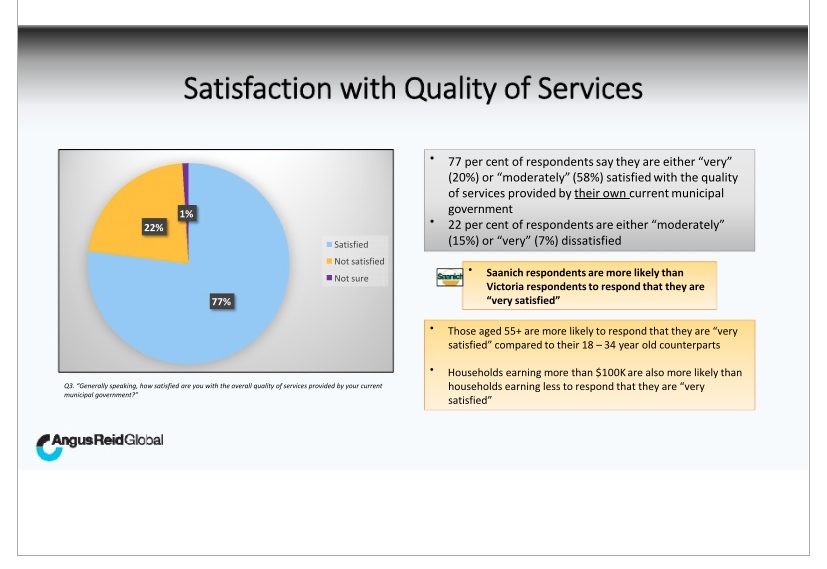
Angus Reid Poll: Citizen Satisfaction with the Capital Regional District
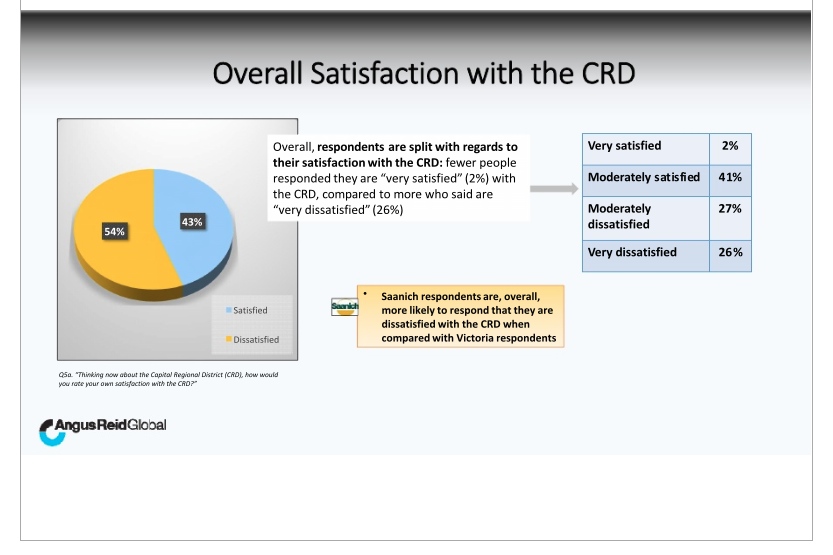 Comment: The above poll makes it clear those pushing for amalgamation favour decreasing that which citizens find most desirable (e.g. local community control) and increasing that which they find least desirable (remote, centralized control). The Capital District Regional Board already supplies the coordinated city services needed in this area and that can be expanded upon by request of the constituent members (as a single entity or in a coordinated effort). Short of amalgamating the entire region, the CRD will remain ‘our city’. Before any of the constituent members decides to jump on the amalgamation bandwagon, they would be well advised to do a bit of reading about the type of governance system under which we currently operate, and to do some reading of studies already completed. (2).
Comment: The above poll makes it clear those pushing for amalgamation favour decreasing that which citizens find most desirable (e.g. local community control) and increasing that which they find least desirable (remote, centralized control). The Capital District Regional Board already supplies the coordinated city services needed in this area and that can be expanded upon by request of the constituent members (as a single entity or in a coordinated effort). Short of amalgamating the entire region, the CRD will remain ‘our city’. Before any of the constituent members decides to jump on the amalgamation bandwagon, they would be well advised to do a bit of reading about the type of governance system under which we currently operate, and to do some reading of studies already completed. (2).
As a final note, I again post a comment from my nephew, Lorne Yochim, a thoughtful young man whose interests in the betterment of the world are diverse.
“Hmmm…I would think that the effects on community spirit and the like depend less on the size of the municipality and more on what people do for and with each other. The suggestion that amalgamation is the solution to municipaliti…es money and service problems misses the point that efficiency is a means, not an end. Also, efficiency pushers are addicted to this mission. For them, a government can never be efficient enough. After the amalgamation, they will see nothing but waste and continue to push for cuts. Service will deteriorate, and that poor performance will be the new justification for further cuts, privatization, etc.” (Lorin Yochim).
The negative outcomes of amalgamation as outlined in Lorin’s comment, are no better demonstrated than in the amalgamated region that is now Metropolitan Toronto.
Harold McNeill
Note: The comments section is again enabled, however, most comments on the subject take place on Facebook or other social media platforms.
Footnotes, including links to various studies
(1) An FB friend and former Mayor helped explain the CRD voting structure:
“The CRD is governed by elected representatives of the participant communities. Some communities elect members (e.g. Saanich and Victoria), but, for others, an appointment is made by the Council with the Mayor often taking on the role.” Figure 4 (above), lists the number of votes available to each member.
The method of selecting representatives to the CRD Board has gained attention as it was felt those Board members are often placed in a conflict of interest between constituency and CRD Board business.
“In that sense, the CRD is a ‘federated’ arrangement of participants where in effect the CRD acts on most ‘initiatives’ by direction of the municipal participants – not the self will of the CRD and hence is not a formal level of governance per see, but is an agent of the participating municipalities.”
Given the concerns about the CRD Board membership and voting structure, that may be a place to start in improving our city structure, the Capital Regional District.
(2) To gain a better understanding of the Reginal District System, link her to this Primer.
(3) Governing in Greater Victoria: The Role of Elected Officials and Shared Services: “British Columbia’s unique system of regional districts, including the Capital Regional District in Greater Victoria, has fostered very high levels of representation and adjustments to appropriate scales for both the provision and production of local government services while local elected officials have incentives to take into account both the costs and benefits of their decisions. The adaptability of this approach to local government organization should serve its citizens well into the future.” (from Executive Summary)
(4) Municipal Amalgamation in Ontario: “Our study reinforces earlier research about the amalgamation of larger cities that suggests that amalgamation in Ontario did not achieve cost savings and in some instances might have actually raised costs. If the government of the day was truly interested in finding efficiencies at the local level, it might have been better off to pursue policies such as shared service agreements rather than municipal restructuring.” (from the Executive Summary)
(5) De-amalgamation in Ontario: Is it the answer? “Study after study has found that the benefits of municipal amalgamation have failed to materialize. Costs generally increase after amalgamation, largely due to a harmonization of costs and wages, and increases in service-efficiency remain elusive. The transitional costs after amalgamation are often quite high and, in some cases, reduce or even eliminate any anticipated immediate cost savings.” (From Introductory Comments)
Links to posts in the Amalgamation Series
Local Communities: Keeping the Spirit Alive: Do you think it possible that one morning you might wake up and your community, as you know it, was suddenly changed forever? I am not referring to a natural disaster such as an earthquake or hurricane, but to a political change that would affect the fabric of your community and the social glue that holds it together. Please take a few minutes to digest the attached post and other links provided in the footer.
Amalgamation: Searching for the Truth: This post provides a short overview and links to four studies that will likely answer many questions as to whether amalgamation of some or all the Municipalities in the CRD or of the Police Services in the Capital Region, is warranted.
Governing Greater Victoria: The Role of Elected Officials and Shared Services: Metropolitan areas in British Columbia have ended up with a much less complex set of institutions and a very high level of shared services compared to elsewhere in Canada. This publication describes how this system has evolved in Greater Victoria, its benefits, and its challenges.
Amalgamation: Questions and Answers: In this post, the contrasting ideologies of the Pro and Anti- Amalgamationists, are placed side by side.
Amalgamation in Greater Victoria: This was the original post on Amalgamation written and posted in 2011.
(1048)
Tags: Amalgamation, Our City, Victoria, B.C., History of Regional Districts, Amalgamation Costs, Surrey RCMP, VicPD, Esquimalt PD, Saanich PD, Angus Reid Poll on Citizen Satisfaction, Capital Regional District, CRD, Saanich
Trackback from your site.

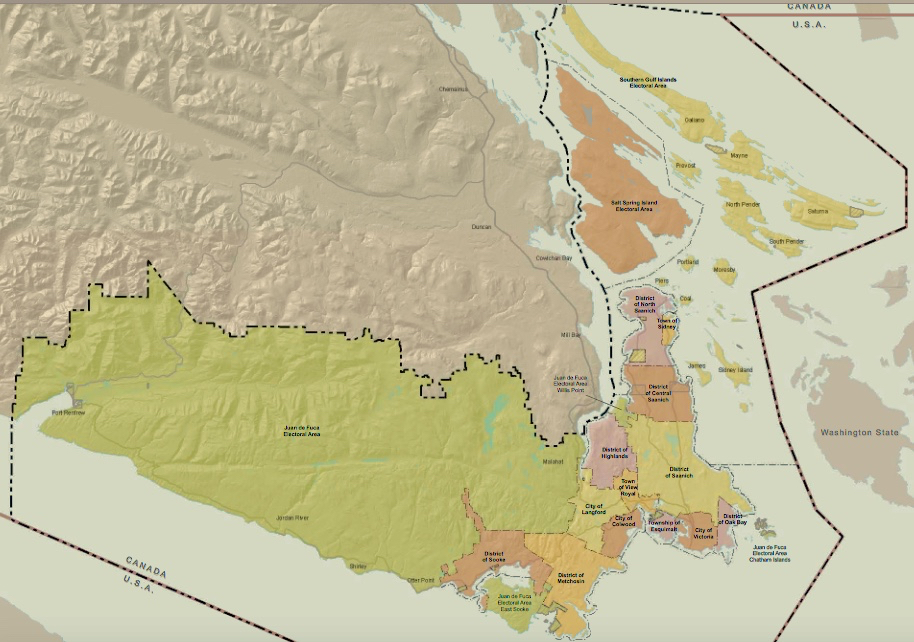
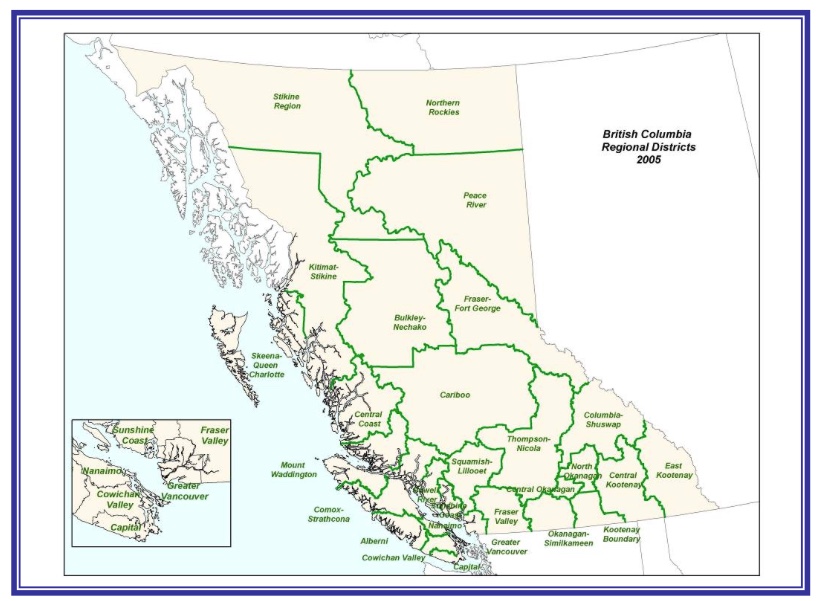
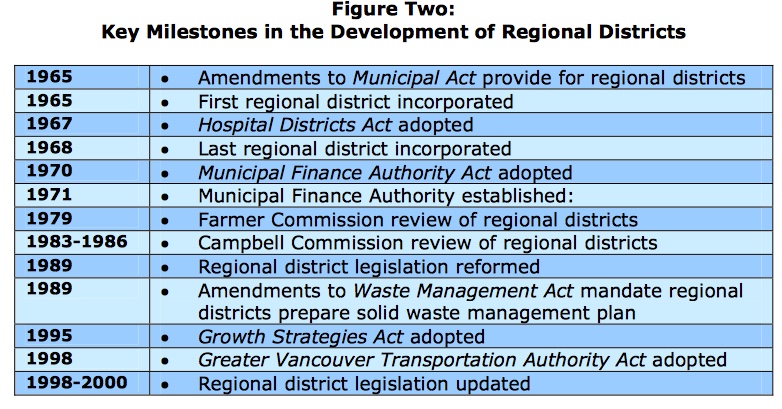
Comments (3)
A VERY COMPREHENSIVE ANALYSIS. ALL POLITICIANS SHOULD READ THIS.
Thanks, Terrance. Your comment came through but went to the Spam folder. Have pulled it out and approved. Can you send another on this post to see if you name is now removed from Spam? I’m not sure why it does that. Cheers, Harold
Guess what? My response went to the Spam folder. Hmm, do you suppose the system is trying to tell me something?